
Once you know what ideas you like and what your preferences are it is important to select materials that match your lifestyle and budget. The materials selection and pricing section helps explain the differences between the available materials and which ones cost more than others.
The Selecting Your Materials section is designed to help you compare popular material options for your project. All products have a list of pros and cons associated with their use on a project and have a price scale to help you get a sense of the price differences between each material. There may be alternative material options in addition to the ones listed here. Familiarizing yourself with the different materials available will help you make important decisions on the design and budget of your shed.
What should I know when choosing my foundation?
This gameplan discusses the pros and cons of three types of foundations for a shed. These foundations types are concrete slab, concrete piers, and a concrete block base.
Concrete Slab:
A concrete slab is an excellent foundation for a backyard shed. It is a strong, permanent foundation with a smooth floor on which to build a shed. Slabs do an excellent job of resisting the forces that frost puts on a shed. Slabs require a compact gravel pad underneath, with a stable soil underneath the gravel.


| Pros: | Cons: |
|---|---|
| ● Concrete makes a great floor. ● Can support reasonably heavy loads. ● Provides a reliable, stable foundation. ● Anchors your shed directly into the slab. ● Keeps framing lumber off of the grounds and thereby reduces rot. ● Provides ground-level access. ● Is easy to sweep and wash. | ● Can settle into the ground over time. ● Is more expensive than other options. ● Can sometimes crack. ● Is permanent, making it hard to remove if the need arises. ● Is an expensive component when considering the entire cost of a shed. |
Concrete Piers:
When completed properly, a pier-based foundation can be just as sturdy as a concrete slab. This is a strong foundation as it is anchored into the ground with concrete, but can also be expensive and has a higher level of difficulty than most DIY-ers are comfortable with.


| Pros: | Cons: |
|---|---|
| ● Works well in most soil conditions. ● Good in areas with frost. ● Permanent foundation. | ● Difficult to construct (especially for DIY-ers). ● Little forgiveness for errors. |
Concrete Blocks:
Using concrete blocks is an easier way to create a shed foundation. It is easier than both a slab and piers but has its drawbacks. This option is most comfortable for a DIY and is also the most cost-efficient.

| Pros: | Cons: |
|---|---|
| ● Quick and easy to install. ● Easy to level. ● Suitable for small sheds. | ● Can sink over time. ● The distance between blocks is not supported. ● Not suitable for sloped surfaces. ● Not as good as other foundation |
A good foundation is fundamental to the success of your shed project. After you have chosen the type of foundation to use, you can begin to choose framing materials and exterior finishes. Choosing these materials makes the dream of having a shed much closer to reality.
| Product | Advantages | Disadvantages |
|---|---|---|
| Wood $$$$ | ● Looks great ● Endless choice of colour stains ● Good lifespan | ● Fading ● Maintenance required ● Expensive |
| Vinyl $$ | ● Good price point ● Endless choice of colours ● Simple install ● Good lifespan | ● Can get damaged from impacts ● Can warp or bubble |
| Hardie (cement board) $$$ | ● Can look good in the right application ● Very durable | ● More expensive than some alternatives ● Installation is difficult |
| Chalet $ | ● Stocked at our stores ● Inexpensive ● Easy to install ● Pre-primed and can be painted | ● Easily damaged ● Maintenance required ● Not as aesthetically pleasing as other options. |
| Barn Board $ | ● Stocked at our stores ● Inexpensive ● Fairly simple install ● Trendy | ● Limited staining options ● Rotting is possible ● Maintenance |
*There may be other materials available, but the materials listed above are common and are DIY friendly.
What windows do you want?
Windows can be installed in sheds to allow natural light to enter the structure. Generally, the larger your window, the more complicated the framing is. The most straightforward course of action for windows is to install windows that will fit between wall studs.
You can avoid framing window rough openings by either not having windows, or buying windows that fit in the small 14 ½” gap between studs. You may be able to find windows specifically designed for this purpose (these windows do not open).
What type of doors do you want?
There are a variety of door options, which include standard hinged doors, sliding doors, roll-up doors and others. The type of door that you want is entirely up to you, as long as your Shed is large enough for the doors you choose. Knowing the exact size of the door you will use before you start to frame will make the job go smoother.
Once you know what ideas you like and what your preferences are it is important to select materials that match your lifestyle and budget. The materials selection and pricing section helps explain the differences between the available materials and which ones cost more than others.
The Selecting Your Materials section is designed to help you compare popular material options for your project. All products have a list of pros and cons associated with their use on a project and have a price scale to help you get a sense of the price differences between each material. There may be alternative material options in addition to the ones listed here. Familiarizing yourself with the different materials available will help you make important decisions on the design and budget of your shed.
What should I know when choosing my foundation?
This gameplan discusses the pros and cons of three types of foundations for a shed. These foundations types are concrete slab, concrete piers, and a concrete block base.
Concrete Slab:
A concrete slab is an excellent foundation for a backyard shed. It is a strong, permanent foundation with a smooth floor on which to build a shed. Slabs do an excellent job of resisting the forces that frost puts on a shed. Slabs require a compact gravel pad underneath, with a stable soil underneath the gravel.


| Pros: | Cons: |
|---|---|
| ● Concrete makes a great floor. ● Can support reasonably heavy loads. ● Provides a reliable, stable foundation. ● Anchors your shed directly into the slab. ● Keeps framing lumber off of the grounds and thereby reduces rot. ● Provides ground-level access. ● Is easy to sweep and wash. | ● Can settle into the ground over time. ● Is more expensive than other options. ● Can sometimes crack. ● Is permanent, making it hard to remove if the need arises. ● Is an expensive component when considering the entire cost of a shed. |
Concrete Piers:
When completed properly, a pier-based foundation can be just as sturdy as a concrete slab. This is a strong foundation as it is anchored into the ground with concrete, but can also be expensive and has a higher level of difficulty than most DIY-ers are comfortable with.


| Pros: | Cons: |
|---|---|
| ● Works well in most soil conditions. ● Good in areas with frost. ● Permanent foundation. | ● Difficult to construct (especially for DIY-ers). ● Little forgiveness for errors. |
Concrete Blocks:
Using concrete blocks is an easier way to create a shed foundation. It is easier than both a slab and piers but has its drawbacks. This option is most comfortable for a DIY and is also the most cost-efficient.

| Pros: | Cons: |
|---|---|
| ● Quick and easy to install. ● Easy to level. ● Suitable for small sheds. | ● Can sink over time. ● The distance between blocks is not supported. ● Not suitable for sloped surfaces. ● Not as good as other foundation |
A good foundation is fundamental to the success of your shed project. After you have chosen the type of foundation to use, you can begin to choose framing materials and exterior finishes. Choosing these materials makes the dream of having a shed much closer to reality.
| Product | Advantages | Disadvantages |
|---|---|---|
| Wood $$$$ | ● Looks great ● Endless choice of colour stains ● Good lifespan | ● Fading ● Maintenance required ● Expensive |
| Vinyl $$ | ● Good price point ● Endless choice of colours ● Simple install ● Good lifespan | ● Can get damaged from impacts ● Can warp or bubble |
| Hardie (cement board) $$$ | ● Can look good in the right application ● Very durable | ● More expensive than some alternatives ● Installation is difficult |
| Chalet $ | ● Stocked at our stores ● Inexpensive ● Easy to install ● Pre-primed and can be painted | ● Easily damaged ● Maintenance required ● Not as aesthetically pleasing as other options. |
| Barn Board $ | ● Stocked at our stores ● Inexpensive ● Fairly simple install ● Trendy | ● Limited staining options ● Rotting is possible ● Maintenance |
*There may be other materials available, but the materials listed above are common and are DIY friendly.
What windows do you want?
Windows can be installed in sheds to allow natural light to enter the structure. Generally, the larger your window, the more complicated the framing is. The most straightforward course of action for windows is to install windows that will fit between wall studs.
You can avoid framing window rough openings by either not having windows, or buying windows that fit in the small 14 ½” gap between studs. You may be able to find windows specifically designed for this purpose (these windows do not open).
What type of doors do you want?
There are a variety of door options, which include standard hinged doors, sliding doors, roll-up doors and others. The type of door that you want is entirely up to you, as long as your Shed is large enough for the doors you choose. Knowing the exact size of the door you will use before you start to frame will make the job go smoother.

Customer Service
1-855-561-1114

Copyright 2023 Turkstra Lumber Company Ltd. | Privacy Policy | All Rights Reserved












